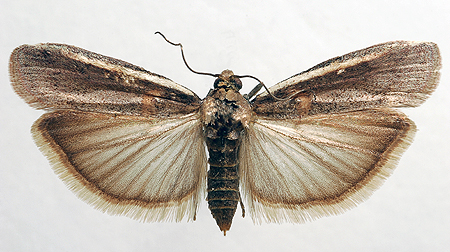Pests
Etiella zinckenella Tr. - Limabean Pod Borer, Pea Podborer, Legume Pod Moth.
Systematic position.
Class Insecta, order Lepidoptera, family Pyralidae, subfamily Phycitinae, genus Etiella.Biological group.
Pest of grain legumes.Morphology and biology.
Body length 8-11 mm, wingspan 19-27 mm. Wings longer than abdomen, folding as roof. Forewing is yellow- or brown-grayish with characteristic light stripe along fore edge, with orange spot on basal third, and with dark fringe. Hindwings are light gray, with dark venation and dark double line near fringe; the fringe is long and light in color. Top of abdomen with a tuft of golden-yellow hairs. Coloration of larvae is variable, from dirty greenish-gray to reddish; body length to 15-22 mm. Pupa is brilliant, brown, fine punctured, to 7-10 mm in length; cocoon is thick, white, and usually covered with soil particles. Number of generations per year reaches three, though the third generation can be facultative. Overwinters as larva. Development of egg lasts 4-21 days, of larva 19-40 days, of pupa 12-18 days, depending on temperature. Life span of adult is 20 days, average fecundity is about 100-300, maximum 600, eggs.Distribution.
Middle belt of Russia (mainly steppe and southern part of forest-steppe area of the European part), the North Caucasus, south Siberia, the Far East (Amur and Sakhalin Regions, Khabarovsk and Primorskii Territories), Baltic States, Byelorussia, Ukraine, Moldavia, Transcaucasia, Kazakhstan, Middle Asia. Western Europe (to the south of Finland), north Africa, Asia Minor, the Middle East, India, China, Korea, Japan, South-East Asia. Introduced into Australia and America.Ecology.
Larva overwinters within a cocoon in soil at a depth of 2-5 cm; pupates in spring. Flight of adults begins in May-June, peaking in the middle of June. Flight is rather extended; terms of the moth flight of different generations are partly overlapped. Some larvae of every generation go into diapause. Moths are active during deep twilights and at night; they need additional feeding. Phytophage develops on more than 80 species of cultivated and wild legumes including soybeans, pea, lentil, lupine, vetch, white (silver-chain) and yellow (Siberian pea shrub) acacia, clover, alfalfa, sainfoin, vetchling, astragals. Prefers large-fruited plant species. Fecundated females lay their eggs one by one on ovaries with dried corolla or on green fruits. Larva lives inside fruit, eating away seeds. Easily passes from one bean to another. Generally the species is thermo- and xerophilous, but ecologically plastic, capable of surviving in a wide range of environments. Droughty springs and summers provoke intensive reproduction of E. zinckenella. Entomophagous insects, particularly Trichogramma, braconid and ichneumonid wasps have a pronounced effect on the decline of the pest population, along with arthropod predators, fungal and bacterial diseases.Economic significance.
Damaged seeds lose their commodity value and become unsuitable for sowing. Sowings of grain legumes located near forest shelter belts composed of true or false acacia (serving as reservations for the pest) are especially strongly damaged. The greatest harm is apparent in the south of Ukraine (including Crimea), North Caucasus, lower Volga, being less common in Moldavia. Control measures: sowing of grain legumes at early-optimal periods; harvest executed at the proper time; 20-25 cm deep under-winter plowing; spatial isolation from plantations of true and false acacia; insecticide treatments soon before larva penetration into beans; resistant varieties. Forecasting is achieved by means of sex pheromone traps.Related references:
Kuznetsov, V.I., ed. 1999. Insects and mites - pests of agricultural plants, V. 3. Lepidoptera, part 2. St.Petersburg: Nauka. 407 p. (In Russian)Meshalova, A.D. 1953. Limabean pod borer and its control. In: Voprosy selektsii i agrotekhniki soi v SSSR. Sbornik nauchno-issl. rabot Vses. In-ta soi i kleshcheviny. Moscow: Gos. Izd-vo sel'skokhoz. lit., P. 137-145 (In Russian)
Pilyugina, O.A. 1951. Limabean pod borer and its control. In: Kratkie itogi nauchnoi raboty za 3 goda (1947-1949). Krasnodar: Nauchno-issled. In-t soi i kleshcheviny. P. 171-179 (In Russian)
Rafal'skii, A.K. 1965. Limabean pod borer in the south of Ukraine and its control. Abstract of Candidate Thesis Agric. Sci. Kiev: Ukrainian Agric. Academy, 21 p. (In Russian)
Shchegolev, V.N., ed. 1960. Agricultural Entomology. Moscow & Leningrad : Sel'khozgiz.448 p. (in Russian).
Viktorov, G.A. 1956. Role of parasitic insects in mass reproduction of limabean pod borer (Etiella zinckenella Tr.). Zool. zhurn. 35(1): 59-73 (In Russian)


